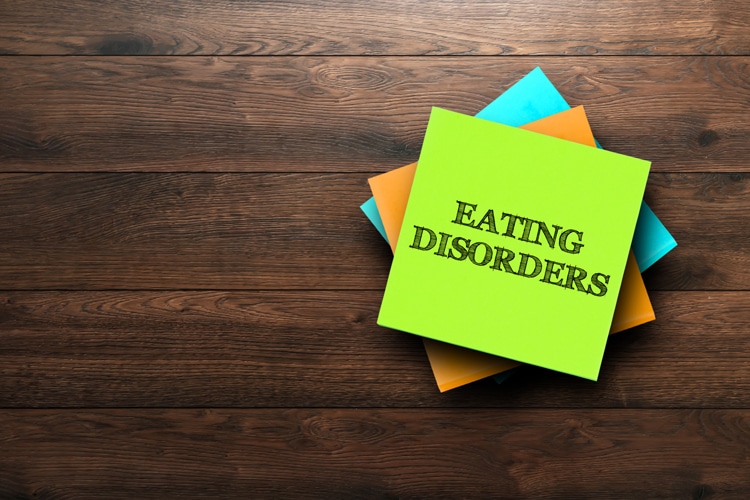Eating Disorders
Eating disorders are categorized as any psychological disorder that impairs psychosocial functioning and physiological health.

Eating disorders are categorized as any psychological disorder that impairs psychosocial functioning and physiological health. Eating disorders have the highest mortality rate among mental illnesses and are complicated, multifactorial diseases controlled by social, familial, and biologic factors. Research indicates that biological factors, such as genetics, may increase the risk of eating disorders. A pattern of genetic inheritance has been found in mental illnesses, such as anxiety, depression, and obsessive-compulsive disorders, all of which are commonly found in those with anorexia nervosa.
Photo Credit: MARHARYTA MARKO / iStock / Getty Images Plus

Anorexia Nervosa
A mental illness, anorexia nervosa is characterized by a distorted body image and a fear of being overweight. Individuals typically present below 15% of their optimal body mass index (BMI); however, a person may have the disorder without looking emaciated. Studies have found that large-bodied individuals also experience the disorder. The disease is characterized by individuals starving themselves through exercise, laxatives, or vomiting.
Photo Credit: vadimguzhva / iStock / Getty Images Plus

Clinical Subtypes
Anorexia nervosa has two clinical subtypes: food restricting and purging. The food-restricting category makes up 50% of all anorexia cases. These individuals will consume between 300 calories and 500 calories a day with a focus on zero to few grams of fat. Patients under the purging subtype follow rigorous dieting coupled with cycles of purging unwanted calories through self-induced vomiting, diuretics, laxatives, and/or exercise. Between 40% and 80% of patients with anorexia use excessive exercise to avoid weight gain.
Photo Credit: leyaelena / iStock / Getty Images Plus

Diagnosis
Diagnosis of anorexia nervosa is based on patients’ weight for their age, denial of having a low weight, refusal to maintain normal body weight, amenorrhea, and use of psychological self-report screening tools. Commonly used screening tests are: Eating Attitudes Test, Eating Disorder Inventory, Eating Disorder Screen for Primary Care, and the SCOFF questionnaire (Do you make yourself Sick because you feel uncomfortably full? Do you worry that you have lost Control over how much you eat? Have you recently lost more than One stone, or 14 lbs in a 3-month period? Do you think you are too Fat, even though others say you are too thin? Would you say that Food dominates your life?
Photo Credit: syahrir maulana / iStock / Getty Images Plus

Medical History
Oral health professionals should be able to recognize the signs of the anorexia nervosa in order to help patients seek help. The medical history provides a great deal of relevant information. A BMI score ≤ 17 is considered mild, 16 to 16.99 is moderate, 15 to 15.99 is severe, and < 15 is extreme. As cardiovascular damage is relatively common among this patient population, hypotension with marked orthostatic changes, bradycardia, and cardiac arrhythmias are common signs of the disorder. Further findings on the medical history could be fatigue, light-headedness, cold intolerance, sleep apnea, constipation, irregular periods, or amenorrhea.
Photo Credit: alexskopje / iStock / Getty Images Plus

Signs and Symptoms
Signs of anorexia may be visible during extra- and intraoral exams. The skin often appears thin, dry, blotchy, or yellow. Fine hair, known as lanugo, may be growing throughout the body. Thinning of the hair and brittle nails may be evident. The eyes appear sunken in with dark shadows and the appearance of dehydration is evident. Intraorally, the findings may be salivary gland enlargement known as sialdenosis, particularly the parotid gland; dry/cracked lips; burning tongue syndrome; atrophic mucosa; and dental enamel erosion. Temporomandibular disorder symptoms, such as dizziness, headache, facial pain, jaw tiredness, tongue thrusting, and a lump feeling in the throat, have been reported. Vitamin C deficiency may contribute to gingivitis and poor wound healing. Oral mucosa in patients with anorexia nervosa show signs of both local and systemic factors, such as petechia on the palate, an orange-yellow palate discoloration, and excoriations from cheek and lip biting, and labial erythema. Labial erythema in a red linear pattern can be found on the vermillion border of the lips and often occurs with exfoliative cheilitis. The thinner mucosa allows the visualization of connective tissue, hence the orange-yellow coloration. The discoloration is due to carotenemia in increased level of serum carotene.
Photo Credit: KatarzynaBialasiewicz / iStock / Getty Images Plus

Oral Health Strategies
Patients who disclose eating disorders should be educated on how to care for their teeth to prevent dental caries. The depleted serum calcium levels can cause reduced buffering capacity of the saliva, increasing caries risk. Patients who use vomiting as their purging method should use products to reduce the effects of acid erosion. In addition, power toothbrushes and mouthrinse can help reduce gingivitis. Patients with anorexia may be taking medications, such as cyproheptadine, clozapine, risperidone, amitriptyline, fluoxetine, clonazepam, and topiramate. Many of these cause xerostomia, orthostatic hypotension, gingival soreness, and abnormal taste, so oral health professionals should be aware of these side effects. If extraoral symptoms, such as orthostatic hypertension, are present, the patient should sit up slowly and wait 3 minutes to 5 minutes before standing.
Photo Credit: KatarzynaBialasiewicz / iStock / Getty Images Plus

Treatment
Treatment of any eating disorder is complex and multifaceted. Typically, individuals will have a team of professionals to treat the eating disorder that may include a nutritionist, psychiatrist, psychotherapist, and behavior therapist. Pharmacotherapy may be used as an adjunct to cognitive behavior therapies. The first step is to persuade the patient and family members that treatment is necessary. Varying levels of care are available, such as inpatient hospitalization, residential care, partial hospitalization, intensive outpatient, or outpatient treatment. Patients with physical symptoms such as depressed vital signs, laboratory findings presenting acute risk, weight that falls below 25% of an ideal body weight, or suicidal thoughts need inpatient hospitalization.

